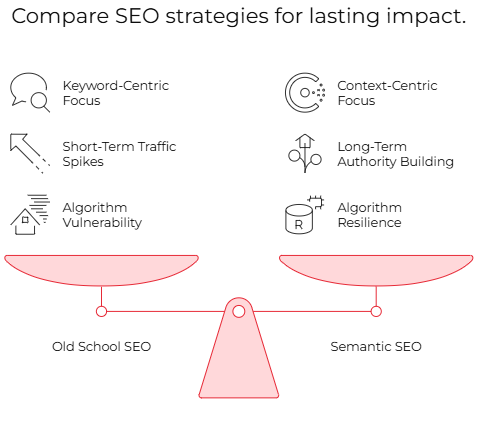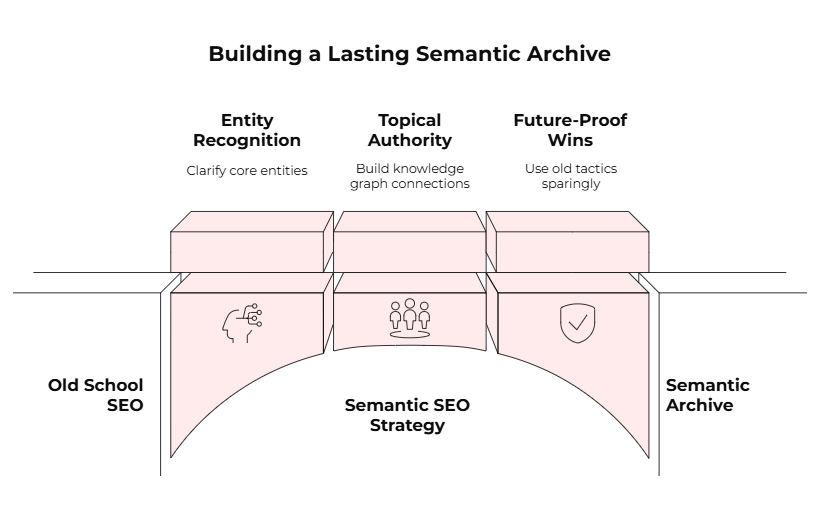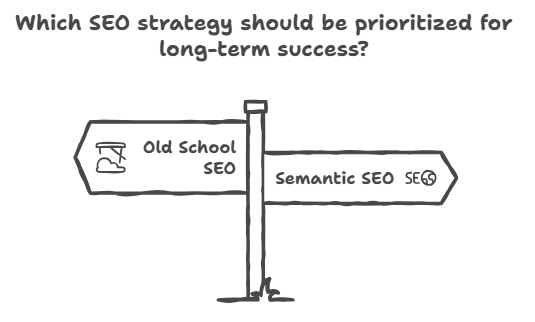Old School SEO vs. Semantic SEO: Why Keyword Chasing Won’t Cut It Anymore (And How to Build a Lasting Archive Instead)
In the fast-evolving world of digital marketing, success hinges on aligning with how search engines like Google understand and rank content from basic keyword matches to deep comprehension of meaning and user needs.
A key part of this shift is moving beyond old school SEO (also known as traditional SEO), which relies on chasing keywords on the surface, manipulating Google with backlink spam, and aiming for quick wins that falter against algorithm updates, losing the compounding marketing value that defines true SEO. But not all optimization strategies are built for the long haul.
Some cling to fleeting tactics, while others embrace a sophisticated approach that creates a referable archive for humanity. Content that endures and attracts revisits over time. This is where the contrast between old school SEO and semantic SEO becomes critical. It is a transformative framework for building sustainable authority.
Let us dive in and uncover how mastering semantic SEO can revolutionize your online presence and create lasting value.
What Exactly is Old School SEO?
Old School SEO and Semantic Dynamics
Old school SEO reflects the early era of optimization: a focus on keywords, backlinks, and mechanical tricks to climb SERPs (Search Engine Results Pages). Strategies align with search engine evolution, but their impact shifts as algorithms advance from simple word matching to intelligent context analysis.
- Keyword-Centric Foundations (Old School): These strategies prioritize exact match keywords, keyword density, and short-tail terms like “buy shoes.” They drive traffic through repetition and volume, but competition is fierce due to commercial intent, and backlink spam risks penalties, undermining long-term gains.
- Context-Centric Shift (Semantic): Terms like “best running shoes for marathon training” signal deeper research. Here, semantic SEO focuses on topics, entities (such as people, places, products, or concepts), and their interconnections in a knowledge graph. It emphasizes comprehensive answers over surface-level matches.
- Intent-Driven Optimization (Advanced Semantic): Queries like “benefits of breathable running shoes” target specific user needs. These align with AI models like BERT and Gemini, where brands compete to deliver trustworthy, holistic content that serves informational, commercial, transactional, navigational, or local intent.
The closer a strategy aligns with user intent and context, the greater its compounding value. Old school SEO might spike traffic briefly but crumbles under updates like Hummingbird or RankBrain, while semantic SEO builds a referable archive that grows authority over months or years. Here’s the catch: depth requires effort upfront, but delivers a legacy of trust and relevance.
Why Old School SEO Feels Like a Gamble
Imagine you’re fishing with an old net, casting it wide for any catch. You might snag something fast, but the net tears under strain, leaving you empty-handed.
Old school SEO is like that fraying net. You could dump resources into keyword stuffing or buying backlinks, only to see rankings vanish with algorithm updates, resulting in lost traffic and wasted effort. Ouch.

Old School vs. Semantic: The Race for Relevance
Table 1: Comparison of Semantic SEO and Traditional SEO
| Feature | Traditional (Keyword-Centric) SEO | Semantic (Context-Centric) SEO |
| Primary Focus | Exact Keywords and Keyword Density | User Intent, Contextual Meaning, and Entities |
| Algorithmic Alignment | Older search systems (rely on lexical retrieval) | Modern AI/NLP Models (BERT, RankBrain, Neural Matching) |
| Content Optimization Goal | Ranking for specific search terms via frequency | Providing comprehensive, holistic answers and establishing topical authority |
| User Experience (UX) | Comparatively lower; risks keyword stuffing | Better user experience; focuses on long-form, valuable content |
The contrast between old school SEO and semantic SEO is like choosing between a sprint and a marathon. It’s about asking: Will this strategy deliver short-term spikes that fade, or build a referable archive that endures for humanity and search engines alike?
Ranking in modern SERPs is the gateway to visibility, but algorithmic sophistication, powered by NLP (Natural Language Processing), vector embeddings, and neural matching, helps to determine whether you achieve fleeting wins or lasting authority.
- Old School Tactics (Keyword-Centric): These rely on lexical retrieval, using tools like TF-IDF (Term Frequency-Inverse Document Frequency) and backlinks from high-authority sites. For terms like “buy CRM software,” competition is intense, with big players leaning on aggressive repetition. Quick gains are possible, but risks like keyword stuffing penalties or algorithm updates (e.g., Hummingbird, RankBrain) often lead to collapse. Short-term spikes with no compounding value.
- Semantic Tactics (Context-Centric): These leverage entities, entity salience, knowledge graphs, and topical depth. For queries like “how to manage customer relationships effectively,” competition is lower. They’re easier to rank for, building visibility through interlinked content. The trade-off? It takes time to establish topical authority and align with E-E-A-T (Experience, Expertise, Authoritativeness, Trustworthiness). But this approach creates a referable archive that users revisit, fostering trust and resilience against shifts like MUM or SGE (Search Generative Experience).
Table 2: Essential Semantic Entities and Concepts
| Term | Type | Function in Semantic Search | Associated Technology/ Concept |
| Entity | Foundational Unit (Node) | Unique, recognizable item used for disambiguation and knowledge storage. | Knowledge Graph, Structured Data (schema.org) |
| Knowledge Graph | Database Structure | A web of entities and their mapped, hierarchical relationships, providing context for search results. | Entity Linking, Knowledge Panels |
| Entity Salience | Measurement Metric | Quantifies the prominence and importance of an entity within a given text using linguistic analysis. | Natural Language Processing (NLP), Google’s Natural Language AI |
| Vector Embedding | Mathematical Concept | Numerical array representing the contextual meaning of complex data in multi-dimensional space. | Vector Search, BERT, Neural Matching |
Here is why this matters:
A high-volume keyword can fail if it ignores context and intent, vanishing in AI overviews or featured snippets. But an entity-rich, comprehensive topic can secure lasting traffic, loyalty, and a foundation for humanity’s knowledge. This brings content that remains relevant as search engines evolve.
The Power of Building a Semantic Archive

You might ask, “If old school SEO offers quick traffic, why invest in semantic SEO?”
Think of semantic SEO as curating a library for humanity. It doesn’t just answer queries, it creates a referable archive that users return to, like a trusted encyclopedia. With topic clusters and pillar content, you craft content that grows in value, drawing repeat visits and establishing your site as a go-to resource.
Striking the Balance: Strategy Meets Longevity
How do you shift from old school tactics to a semantic strategy that builds a lasting archive? It’s about blending keywords, intent, and technical signals like structured data. Here’s a practical approach:
- Start with Entity Recognition: Identify core entities (e.g., brands, locations, products) and use tools like Google’s Natural Language AI to clarify them (e.g., Apple fruit vs. Apple company). Incorporate latent semantic indexing (LSI) principles but prioritize vector embeddings for depth which use synonyms and relationships in headings and early text to boost entity salience.
- Build Topical Authority: Create knowledge graph connections through internal linking and hub-and-spoke models. Use formats like guides or reviews to address informational, commercial, transactional, navigational, and local intent, strengthening your archive with backlinks from awareness content.
- Secure Future-Proof Wins: Use old school tactics sparingly for niches, like long-tail keywords with schema markup (e.g., “affordable CRM for small teams” via JSON-LD). These deliver quicker results with less competition, aligning with rich results like knowledge panels or featured snippets.
Quick Example
For organic skincare products, chasing “buy organic face cream” with old school SEO might seem tempting but faces cutthroat competition via exact matches.
Instead, embrace semantic SEO with “benefits of organic skincare ingredients.” Easier to rank, it builds a referable archive by covering entities like antioxidants, orchards, and health benefits, funnelling users toward purchases while aligning with BERT, Gemini, and hybrid search models.
Watch Out for This Common Mistake!

Short Spikes vs. Lasting Archives
The old school vs. semantic divide reveals a truth: not every tactic builds a legacy. A keyword-dense page might promise fast traffic, but without contextual embedding or entity salience, it risks penalties or irrelevance similarly to a short spike that fades. Meanwhile, a semantic topic cluster lays the foundation for a referable archive, compounding value for humanity over time.
Think of it like architecture. Old school SEO builds a flimsy shack which is quick to erect, but it collapses in a storm. Semantic SEO constructs a stone library: slower to build, but enduring, with singular value decomposition roots and nearest neighbors in vector space ensuring relevance. The best strategies blend both using keywords for accessible wins while crafting a machine-readable archive via structured data.
Avoid the mistake of pursuing lexical search without first evaluating your site’s E-E-A-T. It’s tempting, but it’s a path to obsolescence. Build a semantic foundation first, then layer in targeted keywords.
Wrapping Up: Longevity is Key
SEO is not just about traffic or matches. It is about creating a referable archive that thrives in an AI-powered landscape. By embracing the old school vs. semantic framework, you prioritize strategies that deliver resilient results, from immediate visibility to enduring trust. Start with achievable wins today like entity-based optimization and topical coverage. Later then evolve toward a knowledge graph-driven future. In a world of infinite queries, success lies in building a semantic legacy that shifts from fleeting spikes to a lasting archive for humanity.

Nabil Jalil
Accelerating Sales & Growth for Startups & SMBs | CEO @ BlackGrid | Co-Author of "Money Matters" | SEO Consultant | Based in Los Angeles 🇺🇸 & Kuala Lumpur 🇲🇾
